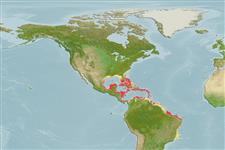>
Eupercaria/misc (Various families in series Eupercaria) >
Scaridae (Parrotfishes) > Sparisomatinae
Etymology: Sparisoma: Latin, sparus = a fish with a golden head + Greek, soma = body (Ref. 45335).
More on author: Bonnaterre.
Environment: milieu / climate zone / depth range / distribution range
Ecologie
marien rifbewoner; diepte 3 - 50 m (Ref. 9710). Subtropical; 34°N - 21°S, 98°W - 28°W (Ref. 55284)
Western Atlantic: southern Florida (USA), Bermuda, Bahamas, and throughout the Caribbean Sea to Brazil.
Lengte bij maturiteit / Grootte / Gewicht / Leeftijd
Maturity: Lm 16.3, range 18 - ? cm
Max length : 64.0 cm TL mannelijk / geslacht onbekend; (Ref. 3802); common length : 38.0 cm TL mannelijk / geslacht onbekend; (Ref. 3802); max. gepubliceerd gewicht: 1.6 kg (Ref. 26340)
Dorsale stekels (totaal) : 9; Dorsale zachte stralen (totaal) : 10; Anale stekels: 3; Anale zachte stralen: 9. Relationship between fork length (FL) and maximum body depth (D): D = 0.10 + 0.33(FL); FL = -0.40 + 3.06(D), for n = 79, length range (cm, FL) = 13.5-25.5 (Ref. 3191). A distinctive, colorful and abundant fish. Young adults and females with scales outlined in darker gray; often bright red below. Super males green, with bright yellow spot at upper edge of gill cover, yellow bar at base of tail, curved orange-yellow mark on caudal fin rays (Ref. 26938). Initial phase fish with a brown head, the scales of the upper two-thirds of the body with pale centers and dark brown edges, the lower third of body and fins bright red. Terminal phase males are green with three diagonal orange bands on upper half of head
Inhabits coral reefs with clear water (Ref. 13628). Young may be found in seagrass beds and other heavily vegetated bottoms. Feeds mainly on soft algae, but has been observed to graze on live corals like, Montastraea annularis (Ref. 6496). Produces a significant amount of sediment through bioerosion using its strong beak-like jaws and constantly re-growing teeth (Ref. 6485). Protogynous; strictly diurnal, spends the night sleeping on the bottom (Ref. 5221). Found singly or small in small groups.
Levenscyclus en paargedrag
Maturities | Voortplanting | Spawnings | Egg(s) | Fecundities | Larven
The type of reproductive behavior is related to the color phase of the males involved.
Cervigón, F., R. Cipriani, W. Fischer, L. Garibaldi, M. Hendrickx, A.J. Lemus, R. Márquez, J.M. Poutiers, G. Robaina and B. Rodriguez, 1992. Fichas FAO de identificación de especies para los fines de la pesca. Guía de campo de las especies comerciales marinas y de aquas salobres de la costa septentrional de Sur América. FAO, Rome. 513 p. Preparado con el financiamento de la Comisión de Comunidades Europeas y de NORAD. (Ref. 5217)
Status op de Rode Lijst van het IUCN (Ref. 130435)
Gevaar voor de mens
Reports of ciguatera poisoning (Ref. 30303)
Gebruik door de mens
Visserij: van minder commercieel belang; Aquarium: Commercieel
Tools
Speciale rapporten
Download XML
Internetbronnen
Estimates based on models
Preferred temperature (Ref.
123201): 25.4 - 28, mean 27.2 °C (based on 206 cells).
Fylogenetische diversiteitsindex (Ref.
82804): PD
50 = 0.5000 [Uniqueness, from 0.5 = low to 2.0 = high].
Bayesian length-weight: a=0.01380 (0.00901 - 0.02115), b=3.05 (2.93 - 3.17), in cm total length, based on LWR estimates for this species & Genus-body shape (Ref.
93245).
Trofisch niveau (Ref.
69278): 2.0 ±0.00 se; based on food items.
Generation time: 2.4 ( na - na) years. Estimated as median ln(3)/K based on 2
growth studies.
Weerstandsvermogen (Ref.
120179): Gemiddeld, minimale populatieverdubbelingstijd 1,4-4,4 jaar (tmax=9; k >0.30).
Prior r = 1.04, 95% CL = 0.68 - 1.56, Based on 1 data-limited stock assessment.
Fishing Vulnerability (Ref.
59153): Low to moderate vulnerability (31 of 100).
Nutrients (Ref.
124155): Calcium = 23.5 [12.5, 48.3] mg/100g; Iron = 0.649 [0.330, 1.159] mg/100g; Protein = 19.1 [17.0, 21.5] %; Omega3 = 0.152 [0.082, 0.269] g/100g; Selenium = 19 [9, 40] μg/100g; VitaminA = 21.8 [5.8, 80.5] μg/100g; Zinc = 0.943 [0.615, 1.606] mg/100g (wet weight);
